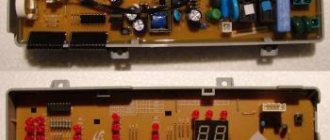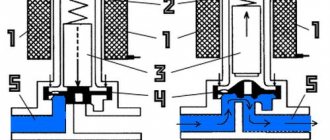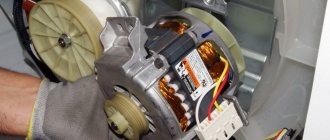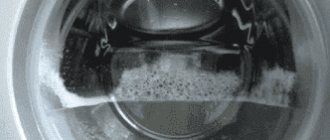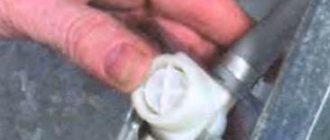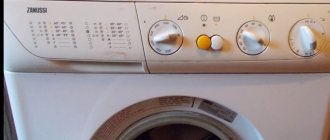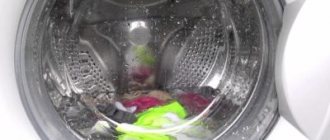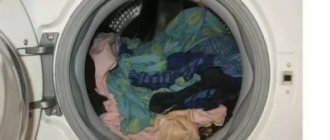What does this mean?
According to the instructions for the washing machine, its internal elements must be kept dry between washes. First of all, this applies to the drum where dirty things are loaded.
If the washing machine fills with water when it is turned off, this can lead to the following problems:
- the spread of an unpleasant odor in the room where the machine is installed;
- the formation of fungus and mold on the inner walls of the drum;
- gradual rusting of the metal elements of the device;
- danger of water pouring out of the washing machine onto the floor of the apartment.
Based on this, it is necessary to take this problem seriously and make every effort to eliminate it.
Water appears when the unit is operating
When parts of the drain system break, partial drainage occurs. Sometimes the liquid does not drain at all and remains in the drum.
The drain filter is clogged
The wash is finished, but there is still liquid in the centrifuge. This problem occurs due to a clogged drain filter. Sometimes small parts in the form of coins, paper clips and buttons get into it.
To clean it, you need to:
- Drain the liquid in the hose.
- Unscrew the filter. To do this, the cover located at the bottom of the body is removed, the part is unscrewed and washed.
- Check the pump located behind the filter for clogging. To do this, you need to start the drain mode. The pump blades should rotate freely. If their movements are difficult, then the pump is clogged with dirt and should be cleaned.
- Insert the filter back and turn on the drain function. If the reason was a contaminated drain, then the system should be fully operational.
Read more ► Why the washing machine does not pick up powder: the main reasons and their elimination
Broken pump
The blockage creates a favorable environment for the emergence of microbes and an unpleasant odor.
The machine makes a lot of noise and tries to drain the liquid, but to no avail. The pump may be broken or clogged with dirt.
You can check its operation as follows:
- Remove the filter and inspect the pump for dirt.
- If no dirt is found, turn on the drain mode.
- The pump blades should rotate. If this does not happen, a major overhaul is necessary.
To repair a part, you need to call a technician who will replace the broken part with a new one. The load on the pump increases when the drain hose is artificially lengthened.
Where does the water come from when the washing machine is turned off?
There are two sources from which water can get into the washing machine drum:
- Sewer system. It is quite easy to recognize such a liquid by its unpleasant odor and dirty appearance. This usually happens with units whose drain is connected to the siphon of a nearby sink.
- Water pipe. In this case, we are talking about clean water seeping through the inlet valve. To check, you need to turn off the tap on the supply hose: the flow of water into the drum should then stop.
Causes of failure
If water flows onto the floor, then the culprit is a leak. It occurs when elements of the machine are damaged, primarily:
- rubber pipes and hoses;
This is an emergency situation in which the washing machine cannot be used. You need to remove the top and back covers and look for leaks using traces of water. After fixing it, the problem will go away.
In this case, water is poured continuously due to the fact that it must reach a certain level. And since it constantly flows out, the supply does not stop.
The washing machine overflows water
If there is no leakage, the source is the following:
- incorrect connection of the MCA;
- valves are faulty;
- breakdown of the pressure switch;
- problems in the control unit.
Let's look at everything in more detail.
Methods for troubleshooting
Having discovered that the switched off washing machine is drawing water, you must immediately close the supply tap. If this is not done, the liquid will eventually begin to pour out of the drum onto the floor. Actions to eliminate the malfunction depend on its nature.
Water comes from the sewer
The reason why wastewater gets inside the washing device is usually an error in the drainage system. Therefore, it is strongly recommended that you strictly follow the manufacturer’s recommendations when installing a household appliance.
Why does sewer water end up in the washing machine drum?
- Poor location of the drain hose . This applies to situations where the drain occurs directly into the bathtub or sink. It is necessary to ensure that the end of the elastic tube is located below the level of the drum and is not immersed in water.
- There is a blockage in the tube. In this case, the waste water simply cannot come out. All you need to do is clean the hose.
- The siphon to which the unit is connected is clogged. This will also be indicated by stagnation of water inside the sink. Washing the siphon is quite simple: the main thing is to carefully unscrew its flask.
To avoid a situation where, when the siphon is clogged, water from the sink begins to move into the washing machine drum, it is recommended to use a siphon valve. It is designed in such a way that it allows fluid to flow in only one direction (in this case, away from the car).
Water comes from the water supply
There is only one reason for this malfunction - failure of the water supply solenoid valve. This type of device cannot be repaired - it only needs to be changed.
Situations that can cause intake valve failure:
- The presence of a large amount of mechanical impurities in the water. The solution is to install dirt filters on the pipes.
- Valve wear. Like any other device, it has a service life.
- Faulty wiring inside the washing machine. A short circuit can cause spontaneous operation of the valve.
What to do to change the intake valve yourself:
- Disconnect the appliance and turn off the water supply.
- Rotate the machine so that direct access to the rear of the body is provided.
- Unscrew the supply hose and remove the top cover.
- Find the valve. It is usually installed immediately behind the supply tube.
- Dismantle the valve, disconnecting it from the tubes and wires.
- Install a new device by connecting all tubes and wiring to it in the correct polarity. To make the procedure easier, it is recommended to photograph the supply lines before dismantling the old valve.
There are several models of intake valves. To purchase the right model, the easiest way is to go to a specialized store along with the broken device.
Water appears in a non-working machine
What should I do if the model is unplugged and water flows into the drum?
- The water supply valve to the machine is turned off. If water continues to flow, check the functioning of the water drain. The model may not be properly connected to the sewer system. The location of the drain hose is checked and the sequence and correctness of the machine connection are carefully examined.
- The check showed that everything was connected correctly. Then it is checked whether the pipe leading to the sewer is clogged. Perhaps, due to a clogged pipe, the water does not find a way out and rises through the hose into the car. In order for water to leave the washing unit freely, it is necessary to remove the blockage.
If all manipulations do not produce results and water does not drain from the tank, the reason may be in the inlet shut-off valve. If it is faulty, the model will need to be disassembled.
Causes of malfunction of the inlet shut-off valve:
- Clogging with water mixed with small stones and gravel.
- The service life of the crane itself has expired. In this case, the problem is eliminated by replacing the worn inlet valve with a new one.
Another possible cause of the problem is faulty wiring of the model. In this case, a specialist is invited to diagnose the electronics and fix the problem. If a faulty electrical part is detected, a specialist can easily replace it.
ATTENTION. You should not disassemble and repair the washing machine yourself if you do not have the skills and qualifications to do so. You should turn off the water supply tap and call a professional technician.
How to avoid trouble
To prevent situations when the washing machine draws water when it is turned off, it is recommended to perform several simple procedures:
- Screw in the shut-off valve after turning off the washing machine. Otherwise, pressure from tap water will constantly be applied to the inlet valve membrane. As a result, the service life of the device will be noticeably reduced. In cases where the supply hose is not equipped with a shut-off valve at all, this situation must be corrected immediately.
- Equip the siphon to which the drain hose is connected with a check valve. Thanks to this, the washing machine will receive additional protection against waste water entering its drum.
- Install a shut-off valve between the siphon and the drain hose. By closing it after finishing washing, you don’t have to worry about clogging or breaking the siphon. The main thing is not to forget to open the valve before turning it on.
- Install a special anti-leak system that reacts to the appearance of moisture on the floor of the room. The Aquastop function inside the washing machine will not help in a situation where water enters a de-energized appliance. The fact is that the sensors of the built-in system are located inside the pan of the machine, and water from an overfilled drum usually flows directly onto the floor.
Situations when a washing machine that is turned off takes in water are rare, but they do occur. In this case, there is no need to panic: the most you have to do is change the intake valve.
Why does the machine fill up when turned off?
It is worth noting that moisture can enter the drum not only through the water supply, but also through sewer pipes. Therefore, when you notice that water has collected inside the device, first inspect it, and then turn on the drain mode. If the liquid is cloudy and smelly, it has returned from the sewer; if it is clear and odorless, it has flowed through the supply hose. The most common causes of this failure:
- Incorrect device connection.
- Antisiphon defect.
- The supply valve is deformed.
- Blockages in the drain.
Let's look at how to fix each problem.
Defective water supply valve
Even when the device is turned off, it remains connected to the water pipe. Only an electromagnetic block with a damper protects the mechanism from pressure. It is usually located at the top of the device near the back wall. This is a plastic assembly with a complex device of hoses, electromagnetic coils, membranes and other protective elements. When the device is turned on, the valve is controlled by the control module. When the system is turned off, it is fixed in the closed state, and the membrane prevents the flow of water inside.
If the membrane or the entire valve does not work, the coil is burnt out, liquid will constantly enter the drum. If the flow is weak, it means the damper is leaking; if it is strong, the entire part has failed. Be sure to turn off the water supply, and then call a technician to replace this element.
Owners of Indesit, Ardo, Whirlpool and Hansa equipment need to be especially careful with the intake unit. It is recommended to close the water valve after each wash.
Anti-siphon valve wear
Not every home has a drain siphon. If you have new sewer pipes and they do not become clogged, there is no reason to install a siphon valve when connecting. After all, this element is needed so that when the pressure in the drain changes, liquid from the washing tank is not drawn into the sewer during operation of the device. Some craftsmen prefer to always install an anti-siphon.
If your washing machine draws water while it is turned off, despite the fact that you have an anti-siphon nozzle, it means it is faulty. Before repairing it, you need to drain the contents of the drum and turn off the device from the network. Also remember to turn off the water tap. Next, the valve flask must be carefully pulled out of the fitting and cleaned. There will be a lot of garbage on it. It is also recommended to soak it for a few minutes in a special solution. If this does not help, you will have to install a new spare part. This item is not worth repairing.
Manufacturers of Zanussi, Miele, Candy, LG devices advise always connecting an anti-siphon when installing the device.
Clogged drain
Often the sewer line becomes clogged beyond the protective flaps, but the liquid will still drain into the washing system. Therefore, if you notice that water is not flowing well from the sink, or there is an unpleasant smell coming from the drain, this indicates that the pipe is clogged. No need to ignore this.
To clean the pipes and not damage the equipment, disconnect the device from the sewer by carefully pulling out the drain hose and securely plug the pipe. After this, use a plunger, special compounds with acids and alkalis, or invite a plumber to clean it.
After the blockage is cleared, plug the device back in and run it idle - without laundry. If the liquid flows out calmly, there is no noise in the pipes, the problem is solved.
Incorrect connection
Another reason for reverse water flow may be an error when connecting the washing machine. If the drain is placed too low relative to the tank, the contents of the sewer will be poured there.
Correctly, the drain should be located at a level no lower than 55 cm from the floor; it is advisable to use a special drain loop - this is a plastic nozzle on the hose that helps maintain the correct angle for the flow of liquid.
If you don’t know how to connect the machine to the sewer, it’s better to turn to professionals. Our experts will help you solve any problem. We service brands Samsung, AEG, Ariston, Bosch and many others. We issue a guarantee for all types of work and install only original spare parts.
